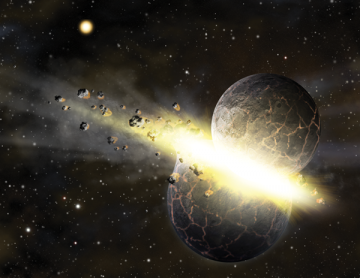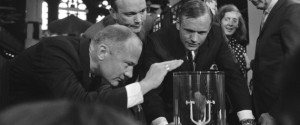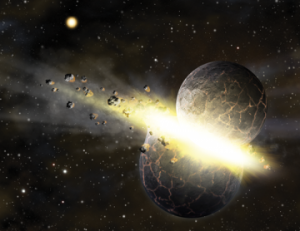June 8, 2014 – It’s over forty years since humans landed on the Moon and scooped up some rock samples to return to Earth. At the time the feat itself of sending six astronaut crews to the Moon and back was a marvel of late 20th century technology. But what about the rocks? What good were they? NASA distributed many samples to museums and universities around the world. Some world leaders even got a souvenir Moon rock to take home with them after a visit to the United States. But other than that what were these rocks good for?
In the American Association for the Advancement of Science’s journal, Science, a June 6, 2014 published study provides clear evidence from those Apollo-collected rocks that give us the goods on the origin of our Moon. The lunar samples exhibit a chemical composition that is different from our Earth. But the samples aren’t completely different and that’s the interesting thing.
The findings support a theory that has been gaining prevalence among astronomers, that the Moon is both part alien and part Earth, the result of an ancient collision between the young Earth and a planetary-sized object around 4.5 billion years ago. At that point in time the Solar System was in its formative stages with lots of wild and crazy things going on. Planetary collisions, asteroid bombardments, comets plunging to a forming Earth, were far more common occurrences.
The scientists have named the alien object that forms half our Moon, Theia, named after the Greek Titan goddess. The researchers found evidence of Theia in the Apollo sample rocks. They did isotopic analysis of samples from three landing sites and found a higher ratio of O-17 to O-16 oxygen isotopes amounting to 12 parts per million greater than that found on Earth. In the words of the study this difference “supports the view that the Moon formed by a giant collision of the proto-Earth with [an impactor].”
How much of Theia ended up in our Moon? The isotopic evidence from the three sites points to the Moon being a 50/50 split between Earth and Theia. But some scientists are of the opinion that the Moon is much more Theia than Earth while others believe the opposite. In any case we know where much of our Moon came from now and in time a future astronaut prospecting on the Moon’s surface may come upon an original surviving piece of Theia. And what would that piece be? The researchers believe it would be an enstatite chondrite, high in the mineral, enstatite, a silicate containing magnesium, and containing iron sulfide.
Where did Theia come from? It may have been a proto-planet that formed close to the Sun as a solar nebual in the early stages of the Solar System. That area would have exhibited low levels of oxygen. Hence the ratios of oxygen isotopes as observed in the samples.
At some point the proto-planet’s orbit would have intersected with Earth in a spectacular slow-motion collision. And after many millions of years with the Earth ringed by chunks of Theia and pieces of our planet, our Moon would have coalesced. To have been an observer at the time, imagine the spectacle of that inexorable, grinding collision and its aftermath. What a sight?
But I have a question for the scientists? Why don’t we find evidence of Theia here on Earth? After all the collision was with our planet and although the Moon formed from the ejecta, shouldn’t there be pieces of Theia still around down here? One possible explanation for the disappearance of any Earth evidence of Theia is the active nature of our planet’s mantle which moves the crust around on conveyor belts leading to continents and continental plates being routinely consumed and reborn in an endless recycling of material.











